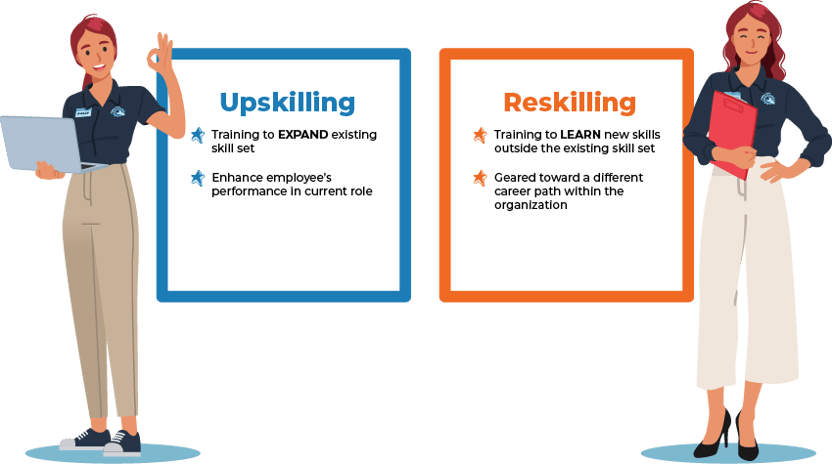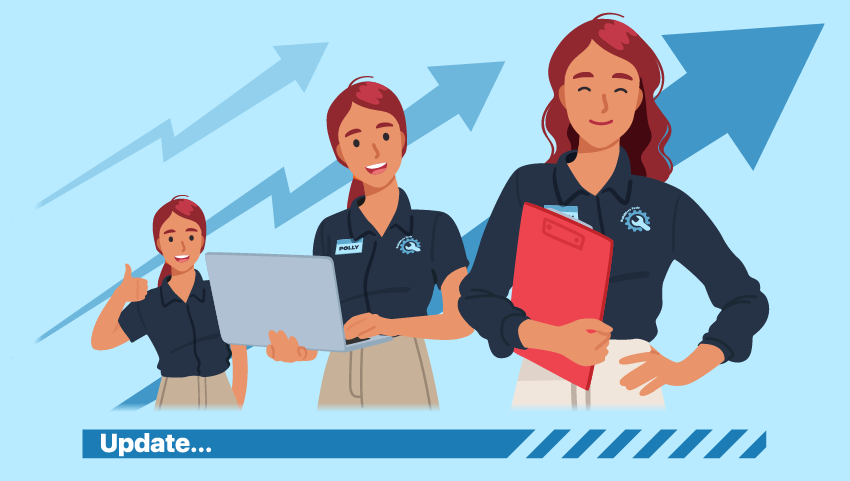Stop me if you’ve heard this one before: Why is the dollar bill so stressed? Answer: Because it’s always afraid of change! Pun aside, I think we can all relate to having experienced, at one point or another, stress around change, albeit a very different kind.
And for employers who have to navigate changes while keeping skilled employees, it can be even more so. Hardly a day goes by when we don’t learn about some new technology or trend that will impact how we do business, requiring some jobs to phase out (research suggests up to 33% of jobs in the US are at risk of becoming obsolete by 2030), others to be created (close to 97 million new roles driven by technological transformation), and some that will shift in their roles and responsibilities. These, along with organizational and economic changes, can lead to skill gaps in their workforce that require action on behalf of them and their employees. The World Economic Forum (WEF) recently predicted that:
- Half of the global labor economy to need reskilling by 2025
- One billion jobs liable to be radically transformed by technology in the next decade
- 680 million people on track to receive improved education, skills, and economic opportunity by 2030
But wait, we’ve got good news!
While there’s no one solution for employers to keep pace with rapid change in their organizations, strategies such as upskilling and reskilling can help future-proof their workforces and reduce the need for organizations to hire externally, which can be costly and time-consuming.
What are upskilling and reskilling
Upskilling and reskilling are elements that – when part of an overall L&D strategy - enable employers to develop an agile environment where current employees can (and will want to) readily close skill gaps and adapt to change for both organizational and professional success. They do differ and offer unique opportunities, however, and sometimes they can even overlap!

According to an article in LinkedIn Learning, upskilling is “When an employee undertakes learning to expand their existing skill set […] These additional skills enhance the employee’s performance in their current role, potentially advancing them along their career path.”
- For example, Polly is upskilling in her role as a customer service representative for BuildMore Tools. She’s been assigned an online course through the company’s learning platform to learn about the new inventory system that will streamline the order and return process for customers and herself. While on the platform, she sees a leadership course on communications for customer service professionals that she signs up for to help her in her current role and which she hopes will help her become a customer service manager.
Reskilling, on the other hand, “involves learning new skills outside of the worker’s existing skill set. These skills are often closely adjacent to their current function but may sometimes be geared toward a different career path within an organization entirely.”
- Polly’s success in customer service and self-motivation have helped her stand out as a great candidate for a store manager position. She will be reskilled with new training and mentorship opportunities to help her grow and succeed in her career path with BuildMore Tools.
Benefits of upskilling and reskilling
Just as they both play important roles, they both also provide numerous benefits to employees and employers—a win-win!
While they provide an advantage to employers that can boost their profitability and impact success, they also help employees feel more valued; a culture in which employees can develop and grow has been shown to help increase satisfaction and retention. Both strategies, in conjunction with a strong talent development plan, promote internal mobility and retention, and reduce the need for external hires. On average, it’s 1.7 times more expensive to recruit, train, and onboard talent from outside your organization, and these employees may end up not being a good fit. Employees cite career growth (or lack thereof) as one of the main reasons they quit; they want to grow in their roles, advance to new ones, and challenge themselves along the way in turn for satisfaction and job security. And for new hires, an organization that develops its employees is attractive to candidates who value career mobility and growth.
Upskilling and reskilling help future-proof workforces by helping them prepare for the next wave of market shifts and changing economic demands. With a pipeline of agile employees who have access to continuous learning opportunities, employers can grow well-rounded teams with an arsenal of capabilities that will allow for a faster, more efficient acclimation to change. This will also position companies to take advantage of opportunities sooner than their competitors, giving them an edge in the market.
Three ways to incorporate upskilling and reskilling into your L&D routine
Future-proofing starts by assessing employees’ current skills and gaps, developing content and training strategies to address those gaps, and keeping employees connected in the process.
Address the skill gap with objective data from a learning platform
A versatile, robust learning platform with talent development can deliver personalized, just-in-time training content, analyze comprehensive objective data from employees and teams, track progress and gaps in real-time, and provide detailed reporting. This objective information can help employers identify which employees are poised for success and which need additional support with the right training and at the right time.
Leverage engaging learning content and personalized development plans
Engaging learning to upskill and reskill comes in many forms, from in-person workshops with informative presentations and guides to microlearning that provides engagement and consistency for in-person, remote, and hybrid workforces.
These strategies are supported by content that’s developed and organized through personal development plans with learning pathways and recommended courses. According to a 2022 LinkedIn Learning Skills Advantage Report, 78% of learners expressed the need for course recommendations based on their individual goals and to address skill gaps that invariably will arise.
Leveraging mentorship … its importance to personal and organizational success doesn’t change!
Even with the best platforms and learning content, the power of connecting with others through mentorship never goes out of style and is crucial to both upskilling and reskilling.
Mentorship—traditionally when a more experienced worker is paired with either a new hire or one being upskilled or reskilled—is beneficial for learning and for satisfaction, growth, and retention. Often, mentorships go beyond reinforcing technical skills and performance to helping employees navigate their unique workplace dynamics and culture. Keeping your employees connected leads to building a learning culture!
Let’s open a conversation about closing your skills gaps.
Do you have additional ways to future-proof your workforce? Let us know in the comments! If you’re looking to introduce or grow upskilling and reskilling capabilities, let’s have a conversation!
Our Cognition Learning & Development platform with learning, talent, and performance management suites is an all-in-one tool to grow and change with your organization. Our learning content solutions and media services teams provide engaging learning experiences for in-person and online training.


